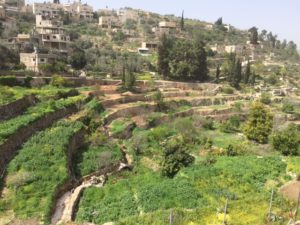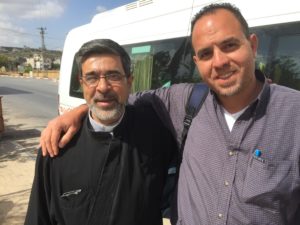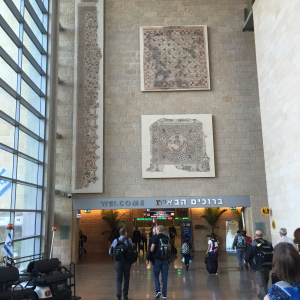13 October, by Katie Archibald-Wooodward
As we drove from Bethlehem into Jerusalem I watched the world as it sailed across my window. I decided to play a little game with myself. Just try to see. Pretend there is no occupation. No military control over another people who cannot enter this side of the wall. Just see what is outside.

View of the Al Makhrour Valley near Bethlehem and Jerusalem
And it was lovely. I drank in the vistas, stone terraces trickling down green hillsides, beautiful houses scattered across others, lush trees lining our highway, a blue cloudless sky over it all. It was so moving I felt compelled to comment out loud to the others with me, “It is such a beautiful day!” It was like a veil had lifted. As I ignored all the other invisible information I knew about the view on the other side of the glass the scene was so pleasant and inviting. If I didn’t know any better, and for these moments I was choosing not to, I would think this land of the Bible had become a thriving community. A glorious, welcoming, and developed land.
The idyllic vision made me feel so happy inside. I was amazed by the whole unfolding experience. I was astonished by the amount of positivity and delight coursing through me—and equally astounded by the tempered emotions and subtle sadness I was suddenly aware of that had been my unconscious state prior to this little mind game. Don’t get me wrong, I experience joy and happiness when I am here, but not because of the landscapes and holy sites, it is because of the people. The dear ones I have developed relationships with.

Father Firas Khoury Diab with our leader/guide, Usama Nicola
It is because of these dear ones that I also feel the sadness I do. Knowing them has made me aware of what was unseen among these vistas. Invisible amidst the pretty neighborhoods and free-flowing freeway. Their vistas are found a few kilometers back. Before the road becomes a highway, just two lanes passing in and out of a military checkpoint with assault-rifle wielding soldiers checking documents and playing on their phones. It is along this road on the other side of a 16-year-old, 25-foot wall that you will find them, my dear ones, in a place called Bethlehem.




